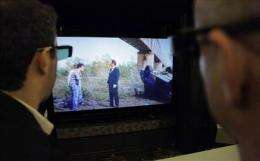TV makers to put out 3-D sets with cheaper glasses

(AP) -- TV makers believe they could blame disappointing sales of 3-D TVs last year partly on the bulky glasses they came with. They're trying to tackle that this year by introducing sets that work with lighter, cheaper glasses of the kind used in theaters.
Manufacturers don't plan to completely supplant 3-D TVs with the heavier, battery-powered glasses that went on sale last year for the first time. But the introduction of a competing technology a year later is a sign that the first 3-D TVs didn't live up to expectations.
LG Electronics Inc. announced Wednesday that it is introducing two sets, a 47-inch and a 65-inch one, later this year that use so-called "passive" glasses. Each will include four pairs. Current 3-D sets usually include one or two pairs of "active" glasses, but some don't include any, and each pair costs about $100.
LG, a South Korean company, is the first major TV maker to announce new products on Wednesday, a day ahead of the opening of the International Consumer Electronics Show in Las Vegas.
Vizio Inc., one of the largest sellers of TVs in the U.S. but not a leader in the high end of the market, which includes 3-D sets, announced in December that it would sell a 65-inch 3-D set with passive glasses.
The "active" glasses are not just bulky but heavy, and they require periodic charging. They darken the image and make it flicker.
The "passive" glasses don't flicker, and as a bonus, glasses from any manufacturer will work with sets from another manufacturer, or in the theater. They darken the image, but not as much as the "active" glasses. However, in LG's implementation, the "passive" glasses cut the resolution of the image in half.
"We're meeting consumers' needs by eliminating some of the pain points" with 3-D sets, said Tim Alessi, director of new product development at LG Electronics USA. "It's going to be the most comfortable viewing experience, just like going to the movies."
Samsung Electronics Co. estimates all manufacturers combined sold 1 million 3-D sets in the U.S in 2010, far short of its initial estimate of 3 million to 4 million.
©2010 The Associated Press. All rights reserved. This material may not be published, broadcast, rewritten or redistributed.




















